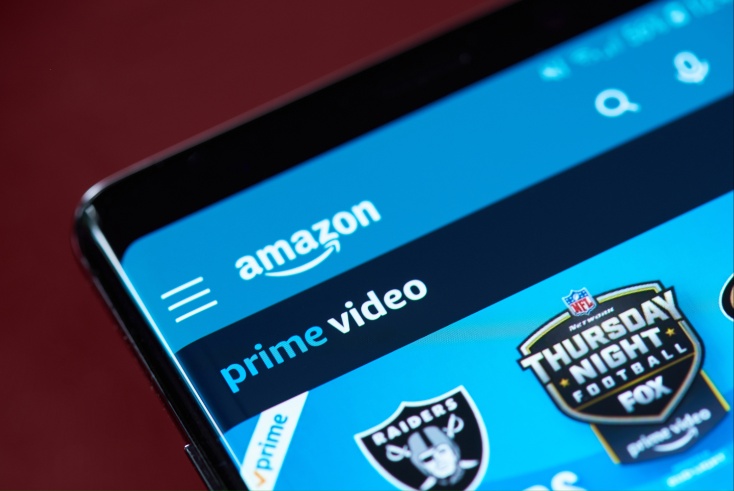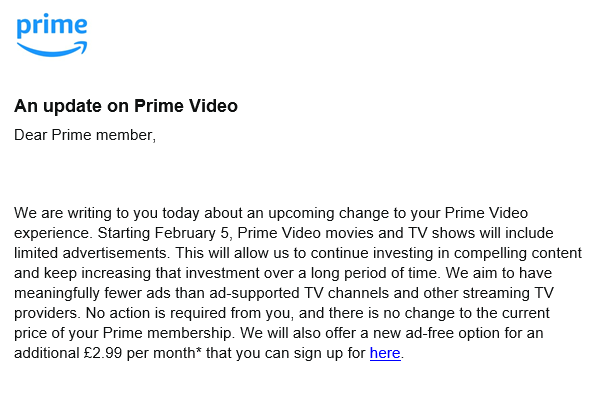Amazon Prime Video with ads: what we know so far

Amazon Prime Video with ads will land in the UK next month. What does this mean for advertisers and how will it compare with other streaming platforms?
In an email to Prime members last week, Amazon announced there would be ads against Prime Video films and TV shows from 5 February in the UK, adding it aimed to have “meaningfully fewer ads” than ad-supported TV channels and other streaming providers.
Users can either keep their current membership, meaning there will now be ads, or choose an ad-free option for an additional £2.99 a month — although live events such as sports and content offered through Amazon Freevee will continue to include advertising.
Current subscription fee for Prime in the UK sits at £8.99 a month (including other perks such as one-day delivery) or Prime Video on its own costs £5.99 a month.
The move to launch an ad tier came in September 2023 when Amazon said it would be rolling out “limited advertisements” in early 2024 to “continue investing in compelling content and keep increasing that investment over a long period of time”.

Analysis: A key consideration for AV plans
Defaulting current subscribers to an ad-funded tier and offering a more expensive ad-free level, as opposed to introducing a cheaper ad-funded tier, has been hailed as a clever strategy by analysts and marketers.
Max Noss, investment director at MNC, told The Media Leader: “At first glance, an automatically enrolled ‘standard’ ad-supported tier is much more appealing than existing options in the streaming/SVOD [subscription video-on-demand] market. The immediate reach advantage over ‘lower-cost’ ad tiers from Netflix and Disney+ will of course make it a key consideration for most AV plans.”
He maintained that Prime’s ad tier success will depend on the details, explaining: “Given the prohibitive nature of high CPMs, limited targeting and low subscriber growth presented by rival streamers, Amazon have a great opportunity to make their advertising offering much more accessible.”
Noss noted Amazon’s two years’ experience in managing free ad-supported streaming TV (FAST) channel Freevee would “strengthen the proposition” on Prime Video as the company “should have resolved any major issues with the platform”.
The UK market would “eagerly anticipate” adtech developments from Amazon, “hopefully mirroring” those launched for the first Black Friday NFL match shown by Amazon in the US, such as audience-based creatives and QR codes, Noss added.
Meanwhile, streaming media analyst Dan Rayburn highlighted that there was “a lot” that is unknown about Prime Video, notably: how many subscribers Prime Video has, what percentage of Prime customers use the video service, the average length of time users spend each month watching content, the volume of ads Amazon plans to place, the ad formats it will use and what type of targeting it will employ.
Nonetheless, there are some known quantities. Rayburn explained: “What we do know is that consumers will watch ads. We see it with Hulu, Max and other streaming services. Netflix said in countries where they have rolled out their AVOD [advertising video-on-demand] option, more than 25% of new users are selecting it. Hulu has said in the past that more than 75% of all their subscribers take the ad tier.
“It’s smart of Amazon to insert ads as they will make more money. It’s that simple. Content creation and acquisition costs are so high that streamers need to monetise the content as best they can and advertising revenue goes a long way in helping them do that. Over time, Amazon will make billions per year on the advertising within Prime video content, but it is too early for anyone to speculate exactly how much revenue.”
One streaming platform that has yet to carry an advertising tier is Apple TV+.
When asked if it would be encouraged to follow the lead of Netflix, Disney and now Prime, Rayburn said: “Apple doesn’t make decisions on their video business based on what Amazon, Netflix or anyone else is doing. So one doesn’t impact the other and their video businesses overall are very different.”
What does the competition think?
Arguably, Amazon does not need to introduce ads to Prime Video given in its Q3 2023 earnings: it reported a 25% year-on-year increase in advertising services sales to $12.06bn.
However, Bank of America analysis cited by Bloomberg forecast that Amazon could make a potential $5bn in ad revenue from an ad-supported Prime Video.
At the Future of TV Advertising Global in December 2023, Netflix and Disney’s heads of advertising spoke about their ad offerings in an increasingly crowded streaming market.
When asked about how he saw Netflix compared with newer players such as Prime and Paramount+, Peter Naylor, Netflix’s vice-president of advertising, told delegates: “It’s great to have worthy competitors.
“I think we keep everything going in the right direction, especially when it comes to the viewer experience. I like our position because we’ve created so much of the streaming paradigm that so many people look at and, frankly, try to emulate.”
Content was king for Netflix as Naylor predicted the streamer would “continue to win” on that front.
Naylor concluded: “We have so much content movies, original IP. We create content in 50 countries around the world where we’re making more content in local markets than ever before. We’ve got the content, we will have the audience and, with that, we’ll have the opportunity. So I feel like we’re in a really wonderful position to compete.”
Meanwhile, Rita Ferro, global vice-president of advertising at Disney, said there was “an energy” in agencies that has never existed before because there are so many new platforms.
She commented that “everyone is shaking the can for two cents” and, as a result, there would be consolidation “pretty aggressively” over the next 12-24 months because there is “no way” all of the streaming players could continue to exist without multiple revenue streams.
Ferro also made the distinction between launching a FAST option and AVOD service.
“There’s a lot of companies trying to get into the streaming game and they’re not in the AVOD business, they’re in the FAST business. And the FAST business is interesting, but it’s not a registered environment, so you don’t have data targeting the same way,” she said.
“Long term, I’m not sure what that looks like. Ultimately from a solution, what you want is full funnel. You want to have the branding opportunity. You want to have the consideration and the conversion and the ability to do that.”
Ferro stressed that launching an ad tier was complicated and “a slow ramp at the beginning”, because there are so many things including the product, workflow and sign-up processes “to get right”.
“I wish you just had to press a button [to launch an ad tier] and it happens, but it doesn’t. We just launched biddable on Disney+ in the US a year into the business and that’s because it takes a while,” she explained. “You can’t sell biddable if you don’t have enough scale in order to do that. Yes, we had programmatic guaranteed, but we would like to get in there and do biddable. It wasn’t really a business that could thoughtfully launch until now.”
These are some of the considerations that Amazon would be looking at with the Prime Video ad tier launch in February, alongside its reputation for adtech and first-party and retail data.



